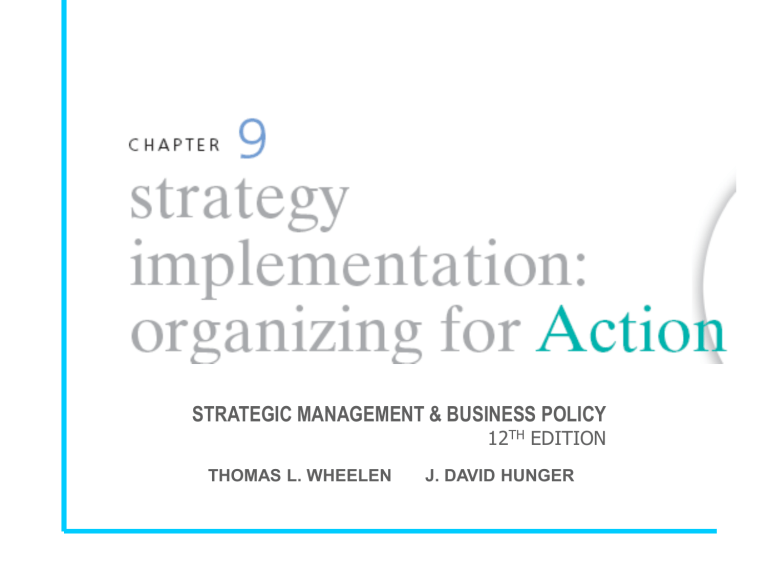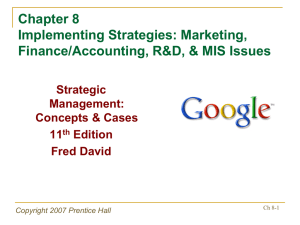Wheelen_smbp12_ppt_09_mod

STRATEGIC MANAGEMENT & BUSINESS POLICY
12 TH EDITION
THOMAS L. WHEELEN J. DAVID HUNGER
Strategy implementationthe sum total of all activities and choices required for the execution of a strategic plan
• Who are the people to carry out the strategic plan?
• What must be done to align company operations in the intended direction?
• How is everyone going to work together to do what is needed?
Prentice Hall, Inc. ©2009 9-2
Common Strategy Implementation Problems
1.
Took more time than planned
2.
Unanticipated major problems
3.
Poor coordination
4.
Competing activities and crises created distractions
5.
Employees with insufficient capabilities
6.
Poor subordinate training
7.
Uncontrollable external environmental factors
8.
Poor departmental leadership and direction
9.
Inadequately defined implementation tasks and activities
10. Inefficient information system to monitor activities
Prentice Hall, Inc. ©2009 9-3
Developing Programs, Budgets and Procedures
Programs make strategies action-oriented
Prentice Hall, Inc. ©2009 9-4
Developing Programs, Budgets and Procedures
Budgetprovides the last real check on the feasibility of the strategy
Procedures (organizational routines)detail the various activities that must be carried out to complete a corporation’s programs
Prentice Hall, Inc. ©2009 9-5
Prentice Hall, Inc. ©2009 9-6
Prentice Hall, Inc. ©2009 9-7
Blocks to Changing Stages
• Internal
– Lack of resources
– Lack of ability
– Refusal of top management to delegate
• External
– Economy
– Labor shortages
– Lack of market growth
Prentice Hall, Inc. ©2009 9-8
Prentice Hall, Inc. ©2009 9-9
International Issues in Strategy Implementation
Multinational Corporationa highly developed international company with a deep involvement throughout the world with a worldwide perspective in its management and decision making
Prentice Hall, Inc. ©2009 9-10
Forces for Standardization
• Convergence of customer preferences and incomes
• Competition from other global products
• Growing customer awareness of international brands
• Economies of scale
• Falling trading costs across countries
• Cultural exchange and business interactions among countries
Prentice Hall, Inc. ©2009 9-11
Stages of International Development
Stage 1: Domestic company
Stage 2: Domestic company with export division
Stage 3: Primarily domestic company with international division
Stage 4: Multinational corporation with multidomestic emphasis
Stage 5: Multinational corporation with global emphasis
Prentice Hall, Inc. ©2009 9-12
Centralization versus Decentralization
Product group structureenables the company to introduce and manage a similar line of products around the world
Geographic area structureallows the company to tailor products to regional differences and to achieve regional coordination
Prentice Hall, Inc. ©2009 9-13







